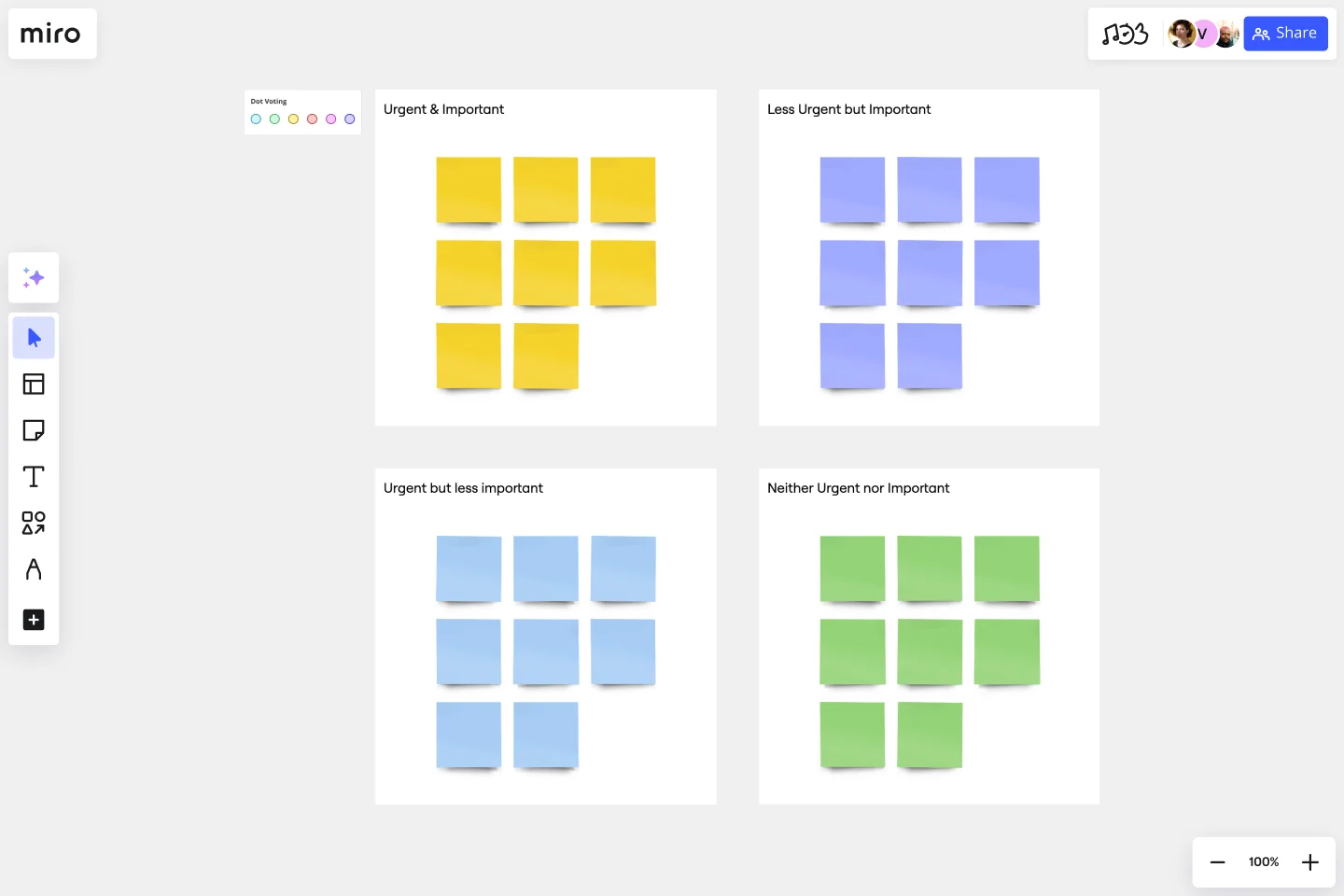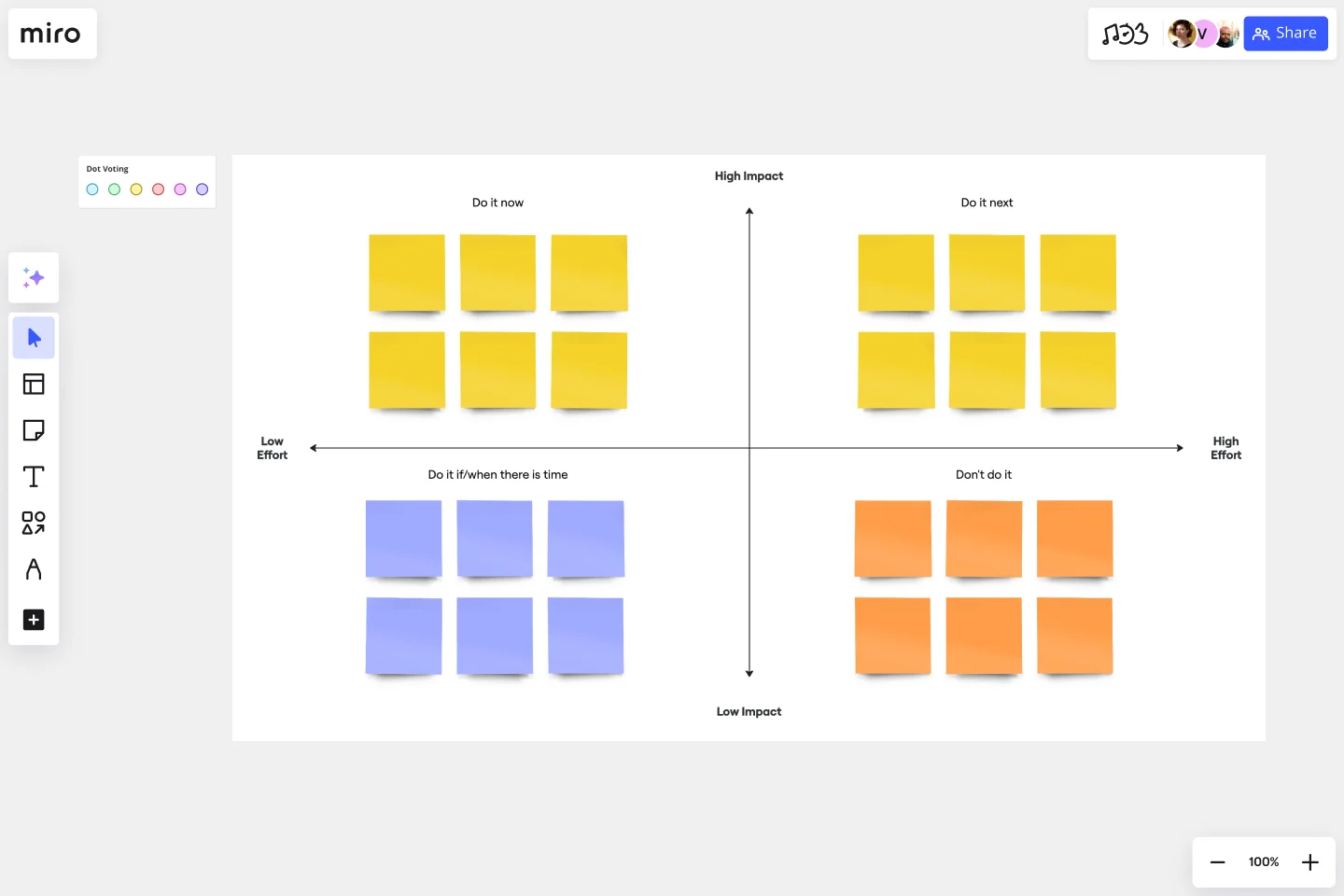
Table of contents
Table of contents
Feeling overwhelmed? Let's build a Six Sigma Priority Matrix together

Summary
In this guide, you will learn:
- What a Six Sigma priority matrix is and its role in structured decision-making
- How to define and select criteria for evaluating projects, tasks, or root causes
- The process of assigning weights and scores for objective prioritization
- How to visually build and interpret the matrix to identify high-priority items
- Ways the matrix supports team alignment and data-driven decisions
- Best practices for applying and updating the priority matrix
Try Miro now
Join thousands of teams using Miro to do their best work yet.
You've got options, maybe too many options. Whether it's deciding which customer issue to fix first, which new feature to build, or which process improvement idea to run with, making the wrong call can waste precious time and energy. This is especially true when you're getting started with methodologies like DMAIC (Define, Measure, Analyze, Improve, Control). But what if you could replace guesswork with a clear, structured way to make choices? Enter the six sigma priority matrix – your new best friend for objective decision-making and a cornerstone of smart lean six sigma prioritization. Stick with us, and we'll break down what it is, why it's awesome, how you can build one step-by-step, and how visual tools can make it way easier.
So, what exactly is a Six Sigma Priority Matrix anyway?
It might sound a bit technical, but trust me, the concept is straightforward and incredibly useful. Think of the six sigma priority matrix as a decision-making grid. You use it to line up your various options (like potential projects, solutions, or even root causes of a problem) and score them against a set of important factors, or criteria, that you define. The real magic? You also decide how much weight each criterion carries, ensuring the most critical factors have the biggest say in the final score. Its roots are in the data-driven world of Six Sigma, which is all about improving processes and reducing errors. That's why it fits so perfectly into lean six sigma prioritization. Within the DMAIC framework, you might use it in:
- Define: Choosing which project will give you the most bang for your buck.
- Analyze: Pinpointing which potential root causes are most likely impacting your process.
- Improve: Selecting the most promising solution to implement from a list of ideas.
Essentially, it helps you apply logic and data where you might otherwise rely on gut feeling or the loudest opinion in the room. The key pieces are simply: the options you're comparing, the criteria you're judging them by, the weighting showing how important each criterion is, and the final scores that help you rank your options.
Why this matrix is your new best friend for making tough calls
Okay, moving beyond just gut checks sounds nice, but what's really in it for you and your team? Using a six sigma priority matrix brings some serious advantages, especially when you're trying to make progress on important initiatives:
- It makes decisions objective: Ever been in a meeting where everyone thinks their idea is the best? This matrix forces you to define why something is important using agreed-upon criteria and data (where possible), taking a lot of the emotion and bias out of the equation.
- It gets everyone on the same page: Building the matrix together means the whole team understands the factors involved and how the final decision was reached. It builds consensus and makes priorities transparent. Seeing it laid out visually really helps here!
- It focuses your energy: Let's be real, you can't do everything at once. This tool shines a spotlight on the options that will likely have the biggest impact based on what matters most to you, ensuring your efforts aren't wasted on lower-priority items. This is lean six sigma prioritization in action – cutting the waste of working on the wrong things.
- It justifies your choices: Need to explain to leadership or stakeholders why you're pursuing Project A instead of Project B? The matrix provides a clear, documented rationale based on those weighted criteria.
- It boosts efficiency: By systematically identifying the highest-value options, you naturally steer clear of spending time and resources on things that won't move the needle much.
Okay, how do I actually build one? (Step-by-step)
Ready to roll up your sleeves? Building your first six sigma priority matrix isn't complicated, and using a visual tool makes the whole process smoother, clearer, and way more collaborative. Think of Miro as your innovation workspace, perfect for mapping this out. Here’s how you do it:
- Nail down your goal: First things first, what decision are you actually trying to make? Be specific. Are you prioritizing features for the next sprint? Choosing which customer feedback theme to address? Selecting a vendor? Knowing your precise goal keeps the whole exercise focused. (Is this part of a larger DMAIC effort? Note which phase it supports!)
- List out your options: Write down all the contenders you're choosing between. Get them all out there! If you're brainstorming these with a team, digital sticky notes on a Miro board are perfect for capturing every idea quickly.
- Pick your measuring sticks (Criteria): What factors will help you judge these options? Think about what's truly important for this specific decision. Examples include: Cost to Implement, Potential Revenue Impact, Customer Satisfaction Boost, Time to Complete, Strategic Alignment, Resource Availability, Technical Risk. Aim for clear, relatively measurable criteria. Brainstorming these as a team ensures everyone’s perspective is included.
- Decide what matters most (Weighting): This step is crucial! Not all criteria are created equal. Assign a weight to each criterion to reflect its relative importance. You could use a scale (like 1-10, where 10 is most important) or percentages (adding up to 100%). Why? Because a project that scores high on a low-importance criterion shouldn't necessarily win out over one that scores slightly lower on a critical criterion.
- Score your options: Now, go through each option and rate how well it performs against each criterion, using a consistent scale (say, 1-5 or 1-10, where higher is better/more favorable). Try to be objective. Use data if you have it!
- Do the math (Calculate Scores): For each option, multiply its score for a criterion by that criterion's weight. Do this for all criteria for that option, then sum up those weighted scores. This gives you a final, overall score for each option. This might sound tedious, but setting it up in a visual grid makes it manageable.
- See the results and talk it over: Rank your options based on their final scores. High score = higher priority. But remember, this matrix is a powerful guide, not an absolute dictator. Use the results to fuel a discussion with your team. Are there any surprises? Does the ranking feel right? Sometimes the discussion sparked by the matrix is as valuable as the ranking itself.
Making it happen in Miro
While you can sketch this out anywhere, using Miro's innovation workspace makes it incredibly easy, especially with a team.

- Start with a template: You can use Miro's DMAIC Analysis template as a fantastic jumping-off point. While it covers the whole DMAIC process, you can easily grab the grid structures or adapt sections within it to build your dedicated six sigma priority matrix.
- Leverage visual planning: Miro's infinite canvas lets you lay out your matrix clearly. Use digital sticky notes for options and criteria, color-code things, draw connections – make it visually intuitive. This is where Miro's visual planning capabilities truly shine, turning abstract criteria into a tangible map.
- Collaborate seamlessly: Invite your team to the board! Everyone can add ideas, help score options, and discuss criteria in real-time, no matter where they are. Use comments or even video chat right on the board for asynchronous feedback or quick sync-ups.
How does this compare to other ways of prioritizing?
You might be thinking, "Isn't this like that other matrix I saw?" Good question! The six sigma priority matrix isn't the only prioritization tool out there, and knowing the difference helps you pick the right one for the job.
- Six Sigma Priority Matrix vs. Eisenhower Matrix: The Eisenhower Matrix is simpler, sorting tasks into four quadrants based on Urgency and Importance (Do, Decide, Delegate, Delete). It's fantastic for quick, individual task management. The six sigma priority matrix, however, handles more complexity. It's better when you have multiple options and multiple weighted criteria, making it ideal for more significant project or solution decisions often found in lean six sigma prioritization.

Six Sigma Priority Matrix vs. Effort/Impact Matrix: This is another visual favorite, plotting options on a grid based on how much effort they require versus the impact they deliver (Quick Wins, Major Projects, Fill-ins, Thankless Tasks). It’s great for comparing those two specific dimensions. The six sigma priority matrix
offers more flexibility by allowing you to define multiple criteria beyond just effort and impact, and crucially, to
weight them based on strategic importance.

Bottom line: If your decision involves several important factors with varying degrees of importance, the six sigma priority matrix offers a more nuanced and data-informed approach than simpler methods.
Bringing it all together visually
There's something powerful about seeing your decision-making process laid out clearly. Instead of abstract ideas floating around in emails or meeting notes, you get a concrete visual map. This is where Miro's innovation workspace really helps translate the six sigma priority matrix from a concept into a practical, collaborative tool. You can easily map everything out, adjust components, see the scores update, and have focused discussions right alongside the matrix itself. Miro's visual planning features make the structure clear, while its collaboration tools ensure everyone is involved, whether you're working together live or contributing on your own time. It makes sophisticated lean six sigma prioritization feel less daunting and more engaging.
Make smarter choices, starting now
Feeling less overwhelmed already? The six sigma priority matrix is a fantastic tool for bringing clarity, objectivity, and team alignment to your decision-making process. By stepping back, defining what truly matters, and systematically evaluating your options, you can move from feeling paralyzed by choice to feeling empowered to tackle the right things first. It’s a simple yet profound shift that's central to successful lean six sigma prioritization and making real progress on your DMAIC projects or any important initiative.Ready to stop guessing and start prioritizing with confidence? Grab one of our priority matrix templates and try building your own in Miro's innovation workspace today!
Got Questions? We've got answers!
Is the Six Sigma Priority Matrix only for huge Six Sigma projects?
Nope! While it has roots there, you can scale it for decisions big and small. Prioritizing features for an app update? Choosing a marketing campaign focus? Deciding which internal process to streamline next? It works! Just adjust the complexity and criteria to fit.
How many criteria should I use?
Good question! You want enough to capture the important factors, but not so many that it becomes unwieldy. Often, starting with 3-7 key criteria is a manageable sweet spot. Quality over quantity!
Can my team build this together even if we're not in the same office?
Absolutely! That's one of the best things about using a tool like Miro's innovation workspace. Everyone can access the board, add their input via sticky notes or comments, participate in scoring, and see the results update live or review them asynchronously. It makes remote or hybrid collaboration on these kinds of exercises a breeze.
Author: Miro Team
Last update: October 22, 2025